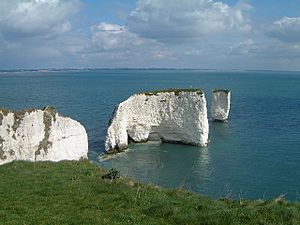Old Harry Rocks facts for kids
Quick facts for kids Old Harry Rocks |
|
|---|---|
 |
|
| Location | Isle of Purbeck, Dorset, England |
| OS grid | SZ0350382564 |
| Coordinates | 50°38′32″N 1°55′25″W / 50.6423°N 1.9236°W |
| Part of | Jurassic Coast |
| Geology | Chalk |
Old Harry Rocks are amazing natural chalk formations. They are found at Handfast Point in Dorset, southern England. These famous rocks include a tall stack and a shorter stump. They mark the very eastern end of the Jurassic Coast. This special coastline is a UNESCO World Heritage Site.
Contents
Where Are the Old Harry Rocks?
Old Harry Rocks are located just east of Studland. They are about 1.5 miles (2.4 km) northeast of Swanage. You can also find them about 3 miles (4.8 km) south of the towns of Poole and Bournemouth.
To the south, you'll see the chalk cliffs of Ballard Down. Much of this area is looked after by the National Trust. You can get great views of the rocks from the South West Coast Path in Dorset.
How Old Harry Rocks Were Formed
The chalk of Old Harry Rocks was once part of a much longer stretch of land. This land connected Purbeck to the Isle of Wight. Over millions of years, the sea slowly wore away parts of this chalk. This left Old Harry Rocks as a headland, which is land sticking out into the sea.
The Power of the Sea
The sea constantly attacks the cliffs. This happens through a process called hydraulic action. This is when waves force air and water into tiny cracks in the rock. Over time, these cracks get bigger.
First, small caves form at the base of the cliff. As the sea keeps working, these caves grow larger. Eventually, they break through to form arches.
From Arches to Stacks
The tops of these arches become weaker. Rain and wind also help to break them down. When an arch collapses, it leaves behind tall, disconnected pillars of rock. These are called stacks. One of these famous stacks is known as Old Harry.
Old Harry's Wife was another stack next to him. But she was worn away by the sea's power. This process is called corrosion and abrasion. Her base became so weak that the top fell off. Now, only a shorter rock, called a stump, remains. Hydraulic action is the main force that causes this erosion. It's the sheer power of the waves hitting the rock.
The Geology of the Rocks
The land around Ballard Down is made of chalk. It also has layers of flint within it. These rocks were formed about 66 million years ago. Over many centuries, the sea has slowly eroded these rock layers. Some of the older stacks have already fallen. For example, Old Harry's original wife fell way back in 1509!
But as old stacks fall, new ones are always forming. This happens when narrow strips of land are broken through by the sea. If you look across the water to the east, you can often see The Needles. These are tall chalk stacks on the Isle of Wight. They are part of the same chalk band as Old Harry Rocks. Only a few thousand years ago, they were still connected to Ballard Down.
How Stacks and Arches Form
To create these amazing stacks, the sea slowly erodes the rock. It works along natural cracks and layers in the chalk. Where the softer chalk meets harder rock, a cave forms. This cave eventually erodes all the way through, creating an arch.
Later, the arch collapses. This leaves behind the tall stacks like Old Harry and his wife (the stump). Other features include No Man's Land, which is a large rock outcrop, and the gap called St Lucas' Leap.
Old Harry is constantly being changed by these natural erosion processes. Eventually, the stack will disappear. But at the same time, new stacks will continue to form. Some people wish to protect these rocks from erosion. However, the National Trust, which owns the stacks, believes it's best to "work with natural processes." This is the most sustainable way to look after the coast.
Legends of Old Harry
There are several interesting stories about how Old Harry Rocks got their name.
- One legend says that the Devil himself, often called "Old Harry," used to sleep on these rocks.
- Another local story suggests the rocks were named after Harry Paye. He was a famous pirate from Poole. His ship would hide behind the rocks, waiting for merchant ships to pass by.
- A different tale tells of a Viking raid in the ninth century. A storm stopped the Vikings. One of the drowned Vikings, Earl Harold, was supposedly turned into a pillar of chalk.
See also
 In Spanish: Old Harry Rocks para niños
In Spanish: Old Harry Rocks para niños



